
Timeless Echoes: Unraveling the Enduring Allure of Ise Shrine
"Explore the captivating paradox of Ise Shrine: where ancient traditions meet modern ideals, challenging our understanding of aesthetics and cultural preservation."
Ise Grand Shrine (Ise Jingū), revered as one of Japan's most sacred Shinto shrines, presents a captivating paradox. Comprising over one hundred individual shrines nestled in the serene cypress forests of Ise City, its heart lies in the Naikū and Gekū, the two main shrines. These embody the essence of 'shikinen sengū,' a tradition of periodic rebuilding that occurs every twenty years. This practice, rooted in Shinto rituals of renewal and purification, has intrigued scholars and artists, sparking debates about aesthetics, cultural preservation, and the interplay between Eastern and Western philosophies.
The continuous cycle of reconstruction challenges conventional notions of authenticity and permanence. Western aesthetics often prioritize the preservation of original artifacts, while Ise's repeated rebuilding embraces change and impermanence. This contrast raises profound questions: How can something be considered 'original' if it's constantly being remade? What does this tell us about cultural values and the way we perceive time and tradition?
This article explores the multifaceted interpretations of Ise Shrine, examining its significance in discourses that differentiate Western and Japanese aesthetics. By acknowledging the universal human need for reflection and explanation, this analysis reveals fundamental similarities in aesthetic traditions, ultimately bridging cultural divides.
Why Does Rebuilding the Ise Shrine Matter?

The Naikū, dedicated to the sun goddess Amaterasu, and the Gekū, dedicated to Toyouke, the kami of food and harvests, showcase the exquisite simplicity of Japanese architecture. Cypress-wood huts, elevated on stilts and topped with miscanthus thatch, stand within compounds covered in white pebbles. Decoration is minimal, with sparing use of gold-copper sheets. The practice of sengū, officially initiated in the 7th century, involves constructing new shrines alongside the old on alternating sites. Once the new shrines are consecrated, the names of the sites are switched. For a brief period, both the old and new incarnations exist side-by-side.
- Cultural Renewal: The rebuilding symbolizes continuous renewal and purification.
- Architectural Purity: Reinforces traditional building techniques and aesthetics.
- Spiritual Significance: Maintains the shrine's sacredness and connection to Shinto beliefs.
- Community Involvement: Provides opportunities for artisans and community members to participate in the construction process.
- Sustainability: Recycling materials from the old shrines demonstrates a commitment to sustainability.
Bridging East and West: A Shared Appreciation for Impermanence
Ise Shrine, with its continuous cycle of rebuilding, offers a unique lens through which to examine the relationship between Japanese and Western aesthetics. While interpretations often emphasize differences, a closer look reveals shared themes of incompleteness, decay, repetition, and aspiration. By recognizing these common threads, we can move beyond rigid categorizations and gain a deeper understanding of the human experience, as reflected in art and culture.
